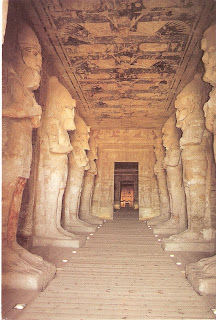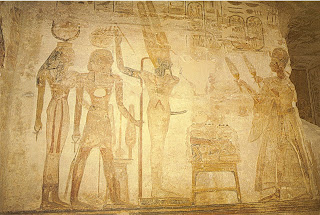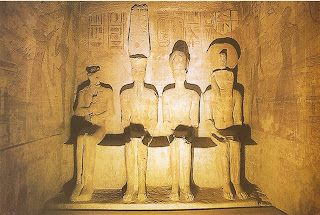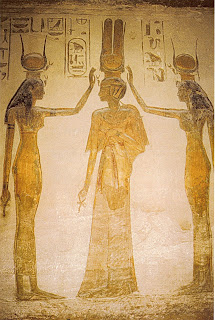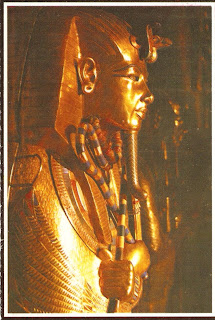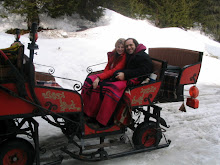After breakfast we borded a feluca, one of the traditional sailing vessels of the Egyptian people. A single sail hangs from a high, flexible mast that curves like a bow. We tacked back and forth across the Nile, all the boats zigging and zagging past each other, throwing spray. !
The old man piloting ours used Milad to steer a couple times, even shoving ropes into Kathryn and my hands occasionally. He had a pirate flag sewn onto his sail.
I had been expecting a short ferry to the island across from us, but instead we enjoyed a leisurely cruise around the entire island, slowing down to view the mausoleum of Akter Khan before docking on the far side of the island.
We also spotted the Old Cataract Inn, a turn of the century European hotel where Agatha Christie is said to have penned part of her “Murder on the Nile."
The site is a sprawling complex of temples and houses, though everything is in great ruin. But many of the inscriptions are in excellent shape and even some paint still sparkles on some of the carvings.
The museum consists of artifacts found at the site including some amazing pieces of pottery with nary a scratch. A mummified gazelle was among the more macabre pieces, along with a mummified human head. (The body had gone missing!) Several sarcophagi, beautifully painted, crowd the hallways.
As we boarded our boat for the return passage, a disheveled old sot leaped on board and immediately went to work helping with the sails. After getting the boat underway, he brought out some beaded necklaces and such for sale. Kathryn bought a couple that were made from some type of dried up plant; they emitted a lovely fragrance; an interesting curio piece to hang in our house somewhere.
After our return, we boarded our cruise ship for lunch. The Diamond is perfect for us, eliciting the feel of a ritzy 1930s vessel, completely in keeping with our Indiana Jones Adventure. The lobby houses a massive chandelier and the décor is red and gold. Our suite boasts a round bed surrounded by mirrored walls with inlaid furnishings of black and gold.
We are on full board minus drinks, and the food is pretty good,served at set times with assigned seating. We share our table with two girls on holiday from England – though they are American and Canadian respectively. But its nice to have someone to compare travel tips with.
The ship set sail more than an hour late, so by the time we got to Kom Ombo it was supposed to be closed, but we were not the only ship arriving late so apparently they stayed open to accommodate us.
">
Divided directly down the center, the left side was reserved for Horus, while Sobek ruled on the right. Hundreds of crocs were actually housed at the site as well as herds of war elephants, although I did not catch how the elephants connected.
The place is awesome, and once again I am overwhelmed at the colossal size of EVERYTHING! I liked this temple a lot cause Sobek is extremely cool looking!
A couple of the ceilings maintained their original color, a white background with the blue painted feathers of Amon-Ra. Spectacular! (check the video!)
After Milad left us, a wandering temple guard showed us a couple interesting things, even taking us inside a locked chamber to show us a god clutching what the man claimed was a stethoscope. I'd seen this necklace on Osirus' neck before, but I didn't argue. Let him believe all tourists are idiots. Of course, he wanted baksheesh for this service, so I offered him two pounds. (.50) He said “Too cheap, too cheap.” So I held out three. He wouldn't take it, cheap, cheap. Twenty, he said. I said, “Take the three or don't take anything.” Guess what he chose? Milad informed me later that they usually get around 30 pounds for this ($6). Well, this time he got .75. Hey, I was out of small bills.
We're running late as usual and there's a Gabalia party on board the ship tonight, where guests are encouraged to wear the traditional long garment of the Nubian people. We thought we'd participate if they were cheap enough. So we stopped to look at a shop and the guy told us 180 pounds. We had no time to barter and simply handed it back. He pursued us down the street, dropping the price at every step. He seemed hung on 70 for a while, but all I had on me was 50. ($10) I said, 50 – no, no, no, 70! I ran on. He followed, “Okay, 60.” I said, 50. No, no. I ran on. He pounds along behind, Okay, okay, 50. I turn and take the dress, handing him the 50. He says, “No 5 for me?” I actually laughed out loud.
Then, we couldn't find our boat. They park these things four and five ships deep, and you must cross through all the other ones to get to shore. Well, they had moved ours after we disembarked! We rushed up and down the dock, Milad questioning everyone and getting a different answer from each person. I finally spotted it, three ships in, and we made it safely on board just in time for supper.
I bought myself one of these outfits on board for a mere $8, and we were joined by Milad, also in costume at the party. We were basically the only people in these outfits, but that's okay, we played along. The whole party had maybe 20-30 people there, but Kathryn and I danced a couple dances; disco fox, cha-cha, and rumba, so I still had a nice time.
I am up early and sitting on the private balcony of our suite. There are only two on the whole ship, I don't know how we managed to score one. I must say I am surprised to find myself cold. We are heading North, so the sun is on the opposite side of the ship, plus we are sailing at a pretty good clip and creating quite a breeze. I'm in my swim trunks, but also wearing my leather jacket.
We're passing another ship right now and I am looking at all the people on the sun deck looking at me. There are dozens if not hundreds of these ships plying the Nile.
Along the bank I see low mud brick buildings, peasants bent in fields of waving wheat, scrawny livestock foraging, and birds swooping low over the placid water. I swear some of the buildings look exactly like the houses in the ruined city on Elephantine Island!
As I watch life slide by on the Nile, I imagine the view is not changed much from when Caesar sailed these same waters with Cleopatra.
